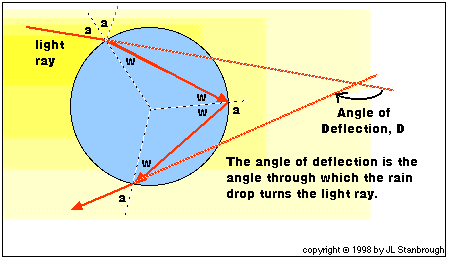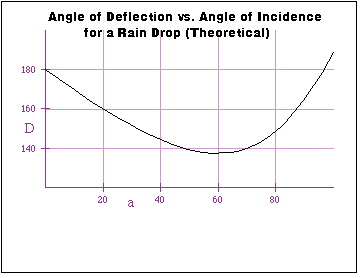
(Mirrored from here)
The angle through which the rain drop turns the light ray is called the angle of deflection for the ray. As the diagram shows, the angle of deflection depends on the angle at which the light ray strikes the drop.
The y-coordinate of the incident light can be changed when clicking a mouse in the area of the upper half of the drop of water and doing a drag.
The angle between the incident light and the refracting
light is maximized in the point that a dot has been put on the
left. Even if the position of the incident light changes in the
neighborhood of this point, the direction of the refracting light
doesn't change too much.
Therefore, the rainbow can be seen in this direction.
Applet and text by Sadahisa Kamikawa © 1997, last update 1997.1.4
 |
(Mirrored from here) The angle through which the rain drop turns the light ray is called the angle of deflection for the ray. As the diagram shows, the angle of deflection depends on the angle at which the light ray strikes the drop. |
 If one graphs angle of deflection vs. angle of incidence (from data collected in a virtual -- or real! -- experiment),
one can clearly see that there is a minimum angle of deflection of approximately 138o (depending on color).
This may ring a bell, since 138o is the supplement of 42o, the "rainbow angle" (sometimes called
the "Descartes angle"). Why does this minimum value correspond to the angle at which you view a rainbow?
If one graphs angle of deflection vs. angle of incidence (from data collected in a virtual -- or real! -- experiment),
one can clearly see that there is a minimum angle of deflection of approximately 138o (depending on color).
This may ring a bell, since 138o is the supplement of 42o, the "rainbow angle" (sometimes called
the "Descartes angle"). Why does this minimum value correspond to the angle at which you view a rainbow?
So, rays that strike the rain drop at an angle of incidence near the angle producing the minimum angle of deflection will tend to form a concentrated, strong beam in which the colors will be widely separated. Rays that strike the rain drop at a small angle of incidence will tend to pass through the drop, and the part of the rays that are reflected inside the drop are spread out relative to one another, while the colors within the rays are not noticeably separated.